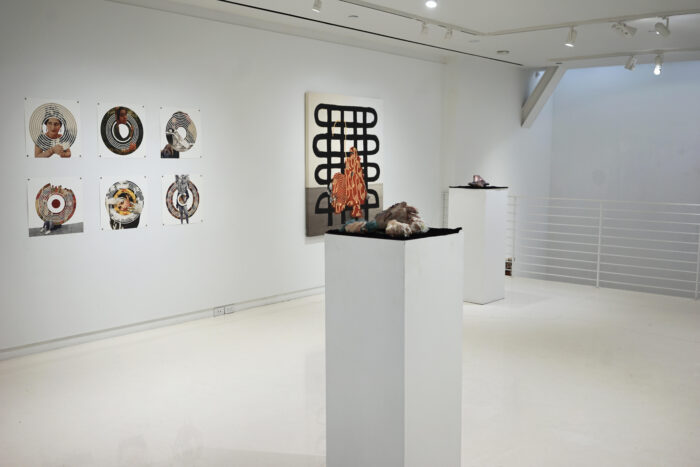
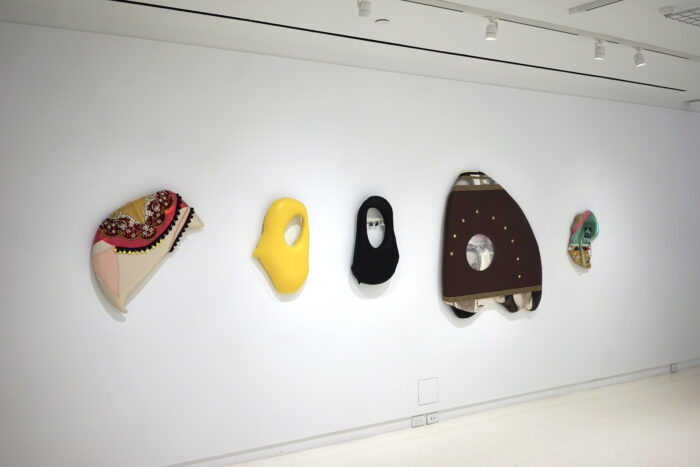
SAPAR Contemporary’s Home Body
February 19, 2021–March 23, 2021
In times of strife, where can we turn?
To avoid spreading a virus with irregular symptoms and unforeseen impacts, we have kept to ourselves and our “pods.” Intense anxiety surrounds every social interaction, as we assume that we have the potential to infect and that everyone else has the power to infect us, too. Loneliness and touch-starvation are almost hailed as the honorable yet inevitable downsides of protecting others.
As we anguish over the one-year anniversary of social distancing and stay-at-home and quarantine orders around the world, turning to the works in SAPAR Contemporary’s current exhibition Home Body, we can experience some of the intimacy and tactility missing from our new, digital lives.
Home Body invites the contemporary viewer to experience touch through its sensory surrogate: sight. Our eyes, rather than our fingertips, trace the contours of Baseera Khan’s “Seats” and conjure the feeling of pleather and metal in our hands. Whether foreign or familiar feelings, our brains populate stimulus. Or perhaps we see ourselves as one of Sola Olulode’s monoprinted subjects, enveloped in an amorous embrace that appears almost foreign now. While we may not be able to touch artworks or loved ones, lest we put ourselves in potential danger, Home Body reassures us that this desire for touch is only human, but that forces out of our control have the power to radically reshape how we live our lives.
Circumambulating the gallery space, the works taunt our desire to kiss loved ones, hug friends, even brush past strangers on the street. Though we may not recognize those depicted in these works, each work expresses the artist’s own understanding of the universal, human experience. While themes of touch and intimacy are universal, these artists resist monolithic notions of race, sexuality, and gender identity through their subversive works. Each of the four artists featured in the show is a womxn of color, a population whose perspective has traditionally been discriminated against in commercial gallery spaces and art history. Yet, these women make space for themselves in the Tribeca gallery and demand their individual identities shine through their works, which are animate, living organisms that we may project our tactile fantasies onto.
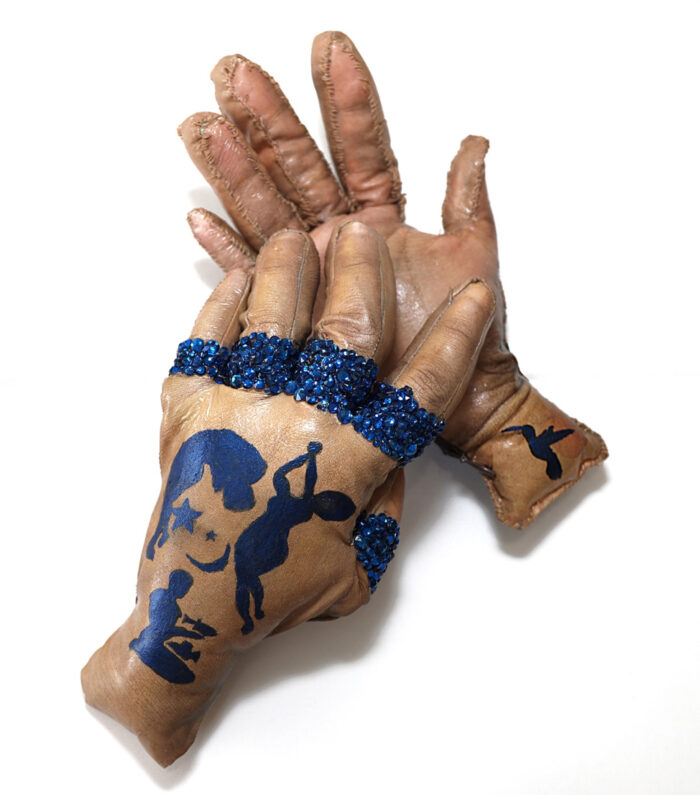
Elia Alba’s “hand portraits” reflect the artist’s belief that hands are like “emotional barometers” that reflect one’s innermost thoughts and existence. Modeled off of the hands of friends, Alba’s “hand portraits” rely on photo-transfer processes to closely mimic human hands. And yet, her portraits are uncanny, bordering on uncomfortable. Visible stitches trace the edges of each finger, and we are inclined to imagine our own hands, signifiers of touch, severed from our bodies and taxidermied for display. Now, our hands, like Alba’s “hand portraits,” are imitations that cannot serve their natural purpose, to reach out and touch. Limp at our sides, our hands have become aesthetic objects that serve no purpose, and their desire to touch is rendered an unnatural fantasy. Stand-out works include Blue Waters and Study (Ivan #3).
For a portrait to focus on a part of the body other than the face is revolutionary in its own right, and suggests that to truly know someone, one must look at the way they express themselves through touch. We do not need to see one’s face to concoct an image of who they are, as Alba’s “hand portraits” are unique in their own right, with their feathers, crystalline beads, and hand-stitched tattoos. And the interiority suggested by Alba’s notion of hands as “emotional barometers” suggests that hands may reflect the inner workings of the mind, shielded from public view, better than any other part of the body.
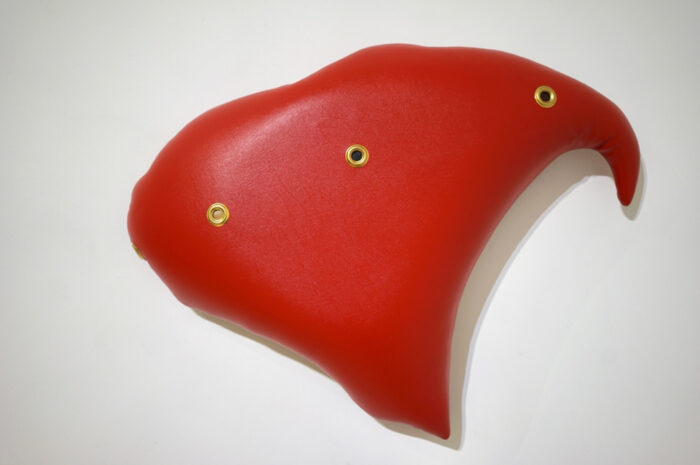
Whereas Alba views the hands as symbols of interiority, Baseera Khan’s “Seats” series goes even deeper. Constructed of pleather, grommets, Islamic textiles, and other miscellaneous fabrics, Khan’s works appear like internal organs that have been surgically-removed from their hosts and put on public display. In a world in which we are pushed to share personal details of our lives with strangers on the Internet, what belongs to just ourselves if not our internal organs? Khan’s works ask us to imagine the feeling of the sinewy, bloody tissue and look deep within ourselves, for our essence, it seems, lives in the liver, the spleen. Perhaps refuge during uncertain times can be found in the physical body itself.
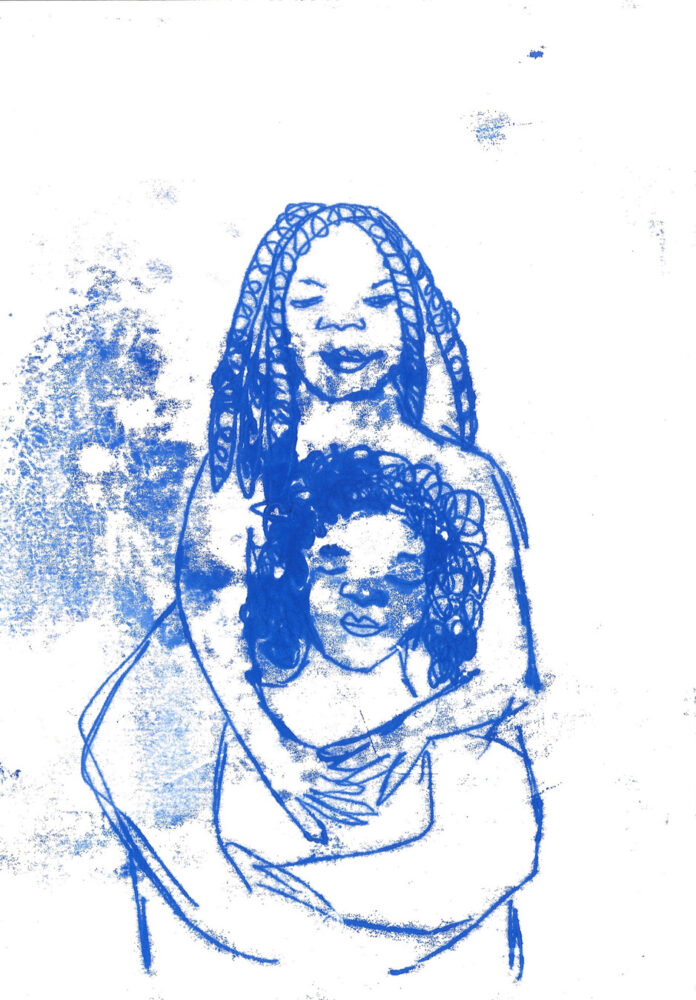
While standing six feet apart from another gallery-goer, I found myself captivated by Sola Olulode’s blue monoprints. Her subjects gingerly hold their loved ones’ faces, melt around the shoulders of their partners, make searing and penetrative eye contact. It was impossible to not feel the distance between myself and the other person in the gallery. And Olulode’s monoprints, I learned, come into being through physical contact made between her own body and the page. In this way, remnants of Olulode’s body are in each work.
Though concerned with intimacy–especially destigmatizing Black queer expression–Olulode is also concerned with the construction of identity, and the way various identities may overlap and contradict one another. Her subjects, self-described as “embodiments of British Black Womxn and Non-Binary Folx,” transcend the gender binary. Blackness is also integral to Olulode’s “queer intimacies,” but her works do not grapple with racism and slavery as do those featured in the New Museum’s current exhibition, Grief and Grievance: Art and Mourning in America. Olulode’s monoprints instead counter suffering with utopian and nuanced celebrations of Black queer self-validation and joy.

Maya Varadaraj’s collages grapple less with tactility and more with agency, as she appropriates imagery from British colonial rule in India to challenge roles assigned to women then and now. Enmeshing them in a universe of machinery, Varadaraj’s subjects rise against the terror of industrial capitalism that so often subjugates women and rule over their environments. In doing so, they create a safe space to inhabit, reflect, retreat, just as we have with our own bodies and minds over the course of the pandemic.
Conclusion:
SAPAR Contemporary’s Home Body, featuring Elia Alba, Baseera Khan, Sola Olulode, and Maya Varadaraj, memorializes pre-pandemic social codes and, at the same time, foreshadows the joy of a distant future full of physical intimacy. With President Biden’s promise that all American adults will have their own Covid-19 vaccine dose by the end of May 2021, the chance to kiss loved ones, hug friends, and brush past strangers on the street will be upon some of us once more; for other regions of the world with slower vaccine rollouts, a mask-less future could be deferred indefinitely. So, for now, Home Body must suffice.
ISABEL GILMOUR is an undergraduate at Columbia University studying art history and business management.
SAPAR Contemporary Gallery + Incubator is located at 9 N. Moore St. New York, New York 10013. Open Tuesday–Saturday, 10 AM–6 PM.
Article by Isabel Joy Gilmour
